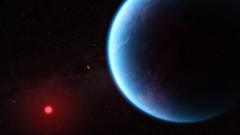Researchers from Cambridge University have found compelling yet tentative evidence of life on the exoplanet K2-18b. The James Webb Space Telescope detected molecules associated with life, sparking excitement about the possibility of extraterrestrial organisms, although independent scientists call for cautious interpretation.
Promising Evidence of Life on Distant Exoplanet K2-18b Discovered

Promising Evidence of Life on Distant Exoplanet K2-18b Discovered
A study using the James Webb Space Telescope suggests the potential for life on K2-18b, highlighting key atmospheric molecules that signal biological processes.
A team of scientists from Cambridge University has made a groundbreaking discovery that may indicate the existence of extraterrestrial life on a distant exoplanet known as K2-18b. The researchers identified potential signs of life in the atmosphere of the planet, which is located approximately seven hundred trillion miles from Earth. Using the powerful James Webb Space Telescope (JWST), they found molecules that are typically associated with biological activity on our planet.
This recent finding marks the second instance of detecting life-related chemicals in K2-18b's atmosphere by the JWST. Lead researcher Professor Nikku Madhusudhan expressed optimism about the significance of this evidence. He stated, "This is the strongest evidence yet there is possibly life out there,” and he anticipates confirming these signals within one to two years.
K2-18b, a planet two and a half times the size of Earth, may host conditions that support life. The presence of molecules like dimethyl sulphide (DMS) and dimethyl disulphide (DMDS) was particularly interesting, as they are produced on Earth by marine phytoplankton and certain bacteria. Prof. Madhusudhan noted that the detected gas levels are thousands of times greater than those found on Earth, suggesting a potential abundance of life.
However, independent astronomers caution against celebrating too soon, as the current data is not definitive. According to standard scientific protocols, a discovery requires a high degree of certainty, specifically about 99.99999% confidence in the results—which the recent findings do not yet meet. They currently stand at a three sigma level (99.7% confidence), an improvement from the one sigma result reported 18 months ago.
Even upon confirming more robust data, doubts remain concerning the origins of the detected gases. As Professor Catherine Heymans from Edinburgh University articulated, the origin of DMS and DMDS on K2-18b requires further investigation. There are numerous geological processes in the universe that could potentially create similar chemical signatures, not necessarily tied to biological life.
The scientific community remains divided on the nature of K2-18b itself, with divergent theories about its structure and composition. Some scientists suggest that the absence of ammonia in the atmosphere indicates a large body of liquid water beneath its surface. In contrast, others propose alternative models, including the idea that K2-18b might be a mini gas giant without a solid surface.
Despite the uncertainties, Professor Madhusudhan remains eager to pursue this research, highlighting the historic potential of their findings. He suggested that the ongoing work could mark a pivotal moment in humanity's quest to understand life beyond Earth, stating, "this could be the tipping point, where suddenly the fundamental question of whether we're alone in the universe is one we're capable of answering.”
The groundbreaking research has been published in The Astrophysical Journal Letters, sparking discussions in the scientific community about our cosmic neighbors and the potential for future discoveries in alien life.








